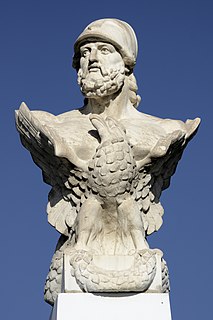This article concerns the period 479 BC – 470 BC.
This article concerns the period 469 BC – 460 BC.
This article concerns the period 459 BC – 450 BC.
Year 476 BC was a year of the pre-Julian Roman calendar. At the time, it was known as the Year of the Consulship of Rutilus and Structus. The denomination 476 BC for this year has been used since the early medieval period, when the Anno Domini calendar era became the prevalent method in Europe for naming years.
Cephalus is a name used both for the hero-figure in Greek mythology and carried as a theophoric name by historical persons.

The Telesterion was a great hall and sanctuary in Eleusis, one of the primary centers of the Eleusinian Mysteries. The hall had a fifty-five yard square roof that could cover three-thousand people, but no one revealed what happened during these events beyond there being "something done, something said, and something shown". This building was built in the 7th century BCE and was an important site until it was destroyed in the 4th century CE. Devoted to Demeter and Persephone, these initiation ceremonies were the most sacred and ancient of all the religious rites celebrated in Greece.
In Greek mythology, Larissa or Larisa was the name of two different figures that appears in various accounts:
Callias was an Ancient Greek statesman, soldier and diplomat, active in 5th century BC. He is commonly known as Callias II to distinguish him from his grandfather, Callias I, and from his grandson, Callias III, who apparently squandered the family's fortune.

Cimon or Kimon was an Athenian strategos and politician.

Phaselis or Faselis was a Greek and Roman city on the coast of ancient Lycia. Its ruins are located north of the modern town Tekirova in the Kemer district of Antalya Province in Turkey. It lies between the Bey Mountains and the forests of Olympos National Park, 16 kilometres (9.9 mi) south of the tourist town of Kemer and on the 57th kilometre of the Antalya–Kumluca highway. Phaselis and other ancient towns around the shore can also be accessed from the sea by daily yacht tours.
Sebaste was a common placename in classical Antiquity. Sebaste was the Greek equivalent (feminine) of the Latin Augusta. Ancient towns by the name sought to honor Augustus or a later Roman emperor.
Pitane, near Çandarlı, Turkey, was an ancient Greek town of the ancient region of Aeolis, in Asia Minor. It was situated near the mouth of the river Evenus on the bay of Elaea. It was one of the eleven ancient Aeolian settlements, and possessed considerable commercial advantages in having two harbours. It was the birthplace of the academic philosopher Arcesilaus, and in the reign of Titus it suffered severely from an earthquake. The town is still mentioned by Hierocles. Pliny the Elder mentions in its vicinity a river Canaius, which is not noticed by any other writer; but it may possibly be the river Pitanes, spoken of by Ptolemy, and which seems to derive its name from the town of Pitane.
The Theseia was an ancient Greek festival held in Athens in the honor of Theseus. This festival was first implemented in the 470s BCE, after an Athenian general known as Cimon son of Miltiades attacked the island of Skyros in search of the bones of Theseus, after receiving instructions from an oracle of Delphi to go there. Once he defeated the local Dolopians, he scoured the island and found a tomb of a gigantic man that he would proclaim to be the remains of Theseus and would bring them back to Athens for proper burial.

The Battle of the Eurymedon was a double battle, taking place both on water and land, between the Delian League of Athens and her Allies, and the Persian Empire of Xerxes I. It took place in either 469 or 466 BCE, in the vicinity of the mouth of the Eurymedon River in Pamphylia, Asia Minor. It forms part of the Wars of the Delian League, itself part of the larger Greco-Persian Wars.
The expression Ancient Europe may be used in a variety of senses:
Cimon Coalemos, was a renowned ancient Olympic chariot-racer of the 6th century BC.
Andromachus is the name of a number of people from classical antiquity:
Coele or Koile was a deme of ancient Attica, originally of the phyle of Hippothontis, and between 307/6 BCE and 201/200 BCE of Demetrias, sending three delegates to the Boule. It was located partially inside and partially outside the Themistoclean Wall.
Hyllarima was an inland town of northeastern ancient Caria. Its site is located near Mesevle in Asiatic Turkey. Hyllarima is the find-site of about 30 inscriptions and is the type-site of one variant of the Carian alphabets. It governed a number of rural sanctuaries, of which the most notable is that of Zeus Hyllos.
This page is based on this
Wikipedia article Text is available under the
CC BY-SA 4.0 license; additional terms may apply.
Images, videos and audio are available under their respective licenses.



